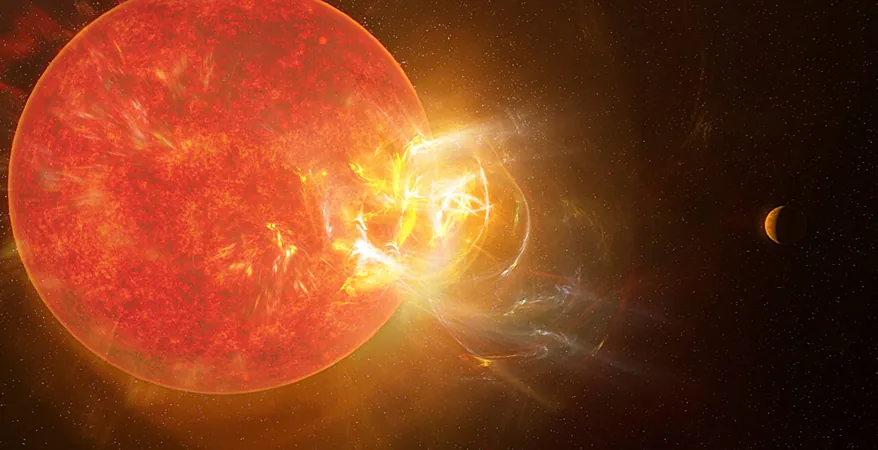
Unveiling the Secrets of Proxima Centauri: The Small Star with Powerfully Intense Flares!
2025-03-27
Author: Wei
Introduction
Proxima Centauri, our closest stellar neighbor at just over four light years away, is not just another M dwarf star; it’s a celestial powerhouse teeming with activity. Known for its impressive flare activity, a new groundbreaking study harnessing the capabilities of the Atacama Large Millimeter/submillimeter Array (ALMA) has uncovered astonishing details about the star's intense emissions in radio and millimeter wavelengths. These findings not only deepen our understanding of the nature of these flares but also raise significant questions about the habitability of planets circling this star.
The Risks of Flares
Proxima Centauri is home to at least one planet within its habitable zone, making its intense flare activity a cause for concern among astronomers. While our own sun’s flares are known to generate stunning auroras on Earth, Proxima Centauri’s flares are on an entirely different scale. They unleash tremendous bursts of energy and stellar particles that can potentially strip atmospheres of vital elements like ozone and water, which are essential for sustaining life.
Breakthrough Research
Leading the research team, Kiana Burton from the University of Colorado and Meredith MacGregor from Johns Hopkins University, used both archival data and new ALMA observations to conduct a comprehensive study of the star’s flare activity at millimeter wavelengths. Their results have been published in *The Astrophysical Journal* and signal a significant advancement in our understanding of stellar flare physics.
Unique Properties of Proxima Centauri
What makes Proxima Centauri uniquely active is its smaller size combined with a robust magnetic field, suggesting a wholly convective internal structure. This structural attribute results in more energetic and frequent flares compared to our sun. These flares occur when twisted magnetic fields snap, releasing a torrent of energy and particles into space.
Implications for Habitability
MacGregor elaborated on the implications of their findings, questioning the impact of such powerful flares on the atmospheres of nearby rocky planets. “Unlike Earth, which enjoys protective layers that allow for life, the atmospheres of these planets could be severely modified or even completely eroded due to the flares’ radiation and particle flux,” she stated.
Pioneering Multi-Wavelength Approach
The recent study also represents the inaugural multi-wavelength investigation employing millimeter observations to explore the mechanics of stellar flares. After analyzing around 50 hours of observations, the team reported a staggering 463 flare events, with energies spanning from 10^24 to 10^27 erg. Each flare, lasting between 3 to 16 seconds, showcases the dynamic nature of this star.
Understanding Flare Frequency
As MacGregor explained, "Observing flares with ALMA allows us to capture electromagnetic radiation across various wavelengths. By delving deeper, we can trace the properties of particles being expelled, offering a clearer picture of the phenomena occurring at Proxima Centauri."
Mapping Energy Outputs
To better understand these phenomena, astronomers are analyzing the star's flare frequency distribution, mapping the number of flares against their energy output. Notably, Proxima Centauri produces a remarkable number of flares, with many appearing across different energy ranges. Moreover, the study highlighted an intriguing asymmetry in the star's highest energy flares, showing that their decay phase significantly outlasts their initial burst phase.
Conclusion and Future Research
This research not only unveils the ferocity of Proxima Centauri’s flares but also hints at profound implications for the future study of exoplanets and their potential for supporting life. The final question remains—can any of them withstand the intense conditions produced by such a fiery neighbor? Only time will tell.


 Brasil (PT)
Brasil (PT)
 Canada (EN)
Canada (EN)
 Chile (ES)
Chile (ES)
 Česko (CS)
Česko (CS)
 대한민국 (KO)
대한민국 (KO)
 España (ES)
España (ES)
 France (FR)
France (FR)
 Hong Kong (EN)
Hong Kong (EN)
 Italia (IT)
Italia (IT)
 日本 (JA)
日本 (JA)
 Magyarország (HU)
Magyarország (HU)
 Norge (NO)
Norge (NO)
 Polska (PL)
Polska (PL)
 Schweiz (DE)
Schweiz (DE)
 Singapore (EN)
Singapore (EN)
 Sverige (SV)
Sverige (SV)
 Suomi (FI)
Suomi (FI)
 Türkiye (TR)
Türkiye (TR)
 الإمارات العربية المتحدة (AR)
الإمارات العربية المتحدة (AR)